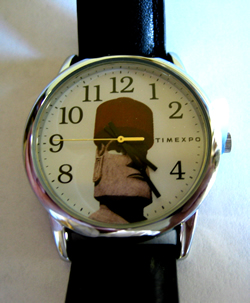Timekeeping and Connecticut Timekeepers
"Excuse me sir, I've been on a long journey and I need to set my carriage clock to match your local standard. Have you the correct time?" The man dressed in overalls stared up at the richly attired gentleman on the buggy seat. "Why, it's noon, of course," the barrel-maker said. The gentleman took off his black top hat as an extension of courtesy. "I failed to glimpse you consulting your pocket watch sir. Is your measurement one of scientific standard, or a gauge that you estimate according to sun's zenith?" The cooper put down his wood mallet and scratched his head. "My son's too young to know anything about telling time and such, Mister. And the only science I can speak to is that which goes on in my belly. It starts to grumble everyday at noon. On account of its lunchtime and I get hungry!"
 Visit TimeExpo Museum in Waterbury, CT
Visit TimeExpo Museum in Waterbury, CT
A clock is a tool that stores energy in such a way that it can be released in consistent measurable increments for gauging time's passing. Modern style devices of this type have been around for only three hundred years: A brief history considering the 360-day, 12-month, sun & moon-regulated calendar was introduced in Egypt over 6000 years ago. In a way, celestial movements are a type of clock themselves. The pendulum clock was introduced in 1656. Crude pocket watches were invented in 1675. In the 18th century, accurate grandfather and other types of sophisticated brass movement timekeepers became available to that sprinkling of wealthy citizens that could afford them. In Connecticut's Naugatuck River Valley: clock makers, brass workers and machinists were instrumental toward improving this situation. In first half of the 19th century, under the freedom and competitive environment of Yankee capitalism, they invented and produced clocks average citizens could afford. Arguably, the greatest of these entrepreneurs, Eli Terry, developed mass-production and interchangeable-part technology to economically produce a form of "box clock." Amazingly, Terry's famous "Pillar and Scroll Mantle Clock" sold over 6000 models in 1817, the first year of its production. The $15 to $20 priced timekeeper housed in an elegant case was instrumental in sprouting competing clock models and makers not only in Connecticut but worldwide.
Waterbury's brass industry giant, Benedict & Burnham would throw its hat into the clock-making ring in the 1850's, establishing The Waterbury Clock Company. Technologically initiated by brothers Noble and Chauncey Jerome (top clockmakers hired by the Benedict & Burnham), Waterbury Clock Company would thrive and eventually prove to be the ancestor to: Timex Corporation, U.S. Time, Robert Ingersoll & Brothers and Waterbury Watch. While clock technology had blossomed by the mid 19th century, society's understanding of timekeeping and even time itself was still in its infancy. Arguably, it still is.
One of my favorite stories in Kathleen McDermott's 1998 book, "TIMEX – A Company and its Community" concerns adjustments Americans were forced to make following the introduction of speedy transcontinental trains.
Time had always been measured region-by-region and town-by-town according to the sun's passage. Not surprisingly, in the mid 19th century hundreds of local time zones spread their way east to west across American. This was easy enough to adapt to in the stagecoach days when long journeys took weeks or months to complete. Four thousand mile rail lines and stream-powered trains changed all that. Timetable errors became numerous, overwhelming and potentially disastrous concerning shared train tracks. Adjustments were gradually instituted. Finally, noon, November 18, 1883 the United States established four standard time zones: Eastern, Central, Mountain and Pacific. While the conversion undoubtedly seemed a plan of genius to the engineers who devised it, the new "Railway Time" was not so easy understood by most citizens across the country. "How can a single day have two noons?" they puzzled. "And I don't understand how I can take a five minute horse ride west, over some time-zone line, and have my pocket watch read 55 minutes different than the folks I rode only a mile or two to visit? Time never went backwards in the good old days-before trains and technology started changing everything!"
From an antique collectors' standpoint, one of the interesting aspects of this period are surviving products inevitably produced to lessen some of this confusion. Market-oriented companies like Ingersoll produced pocket watches with multiple hands displaying both the "old time" and the "new time." An 1883 company advertisement for their pocket watch reads "Dial No 1 represents the starting point of the new standard time at 12 o'clock, Nov. 18th … Dial No. 2 represents the old time at the exact time when the new time starts. When it is 12 o'clock in the Eastern Section, it will be at 11 o'clock all through the second (Central) section."
"A day with two noons and a watch with two times!" Next time you drive by the Timexpo Museum off Route 84 in Waterbury and you see the Easter Island statue standing prominently on the grounds, think about this: Time's passing has as much to do with travel and history and physics as is has to do with your Timex watch. When it comes to fully understanding what "time" is all about, we humans have probably much more to learn than we know. Maybe more than we can ever know. Time will tell.

